remote start CADILLAC SRX 2008 1.G User Guide
[x] Cancel search | Manufacturer: CADILLAC, Model Year: 2008, Model line: SRX, Model: CADILLAC SRX 2008 1.GPages: 448, PDF Size: 5.61 MB
Page 209 of 448
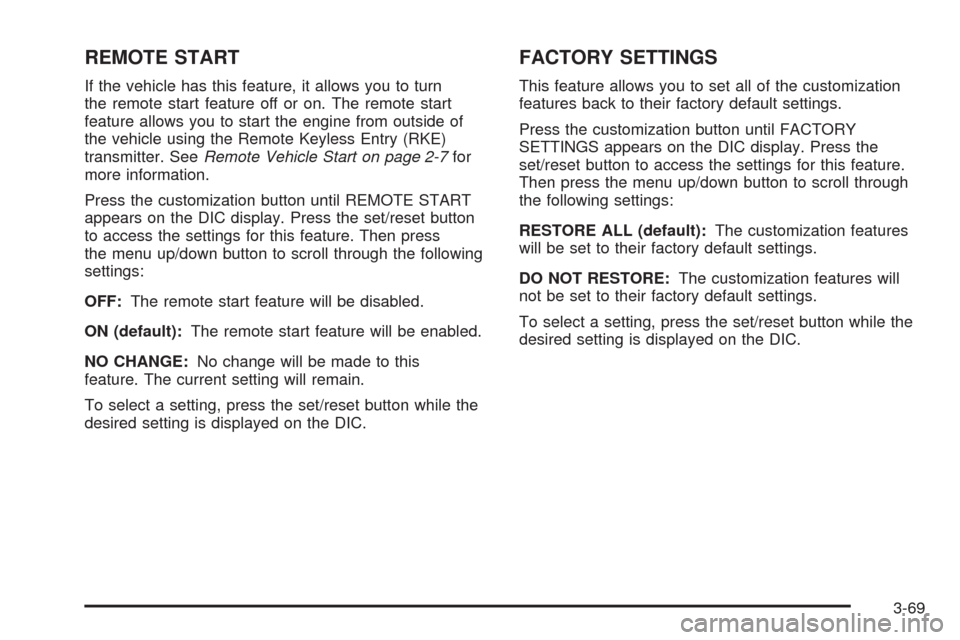
REMOTE START
If the vehicle has this feature, it allows you to turn
the remote start feature off or on. The remote start
feature allows you to start the engine from outside of
the vehicle using the Remote Keyless Entry (RKE)
transmitter. SeeRemote Vehicle Start on page 2-7for
more information.
Press the customization button until REMOTE START
appears on the DIC display. Press the set/reset button
to access the settings for this feature. Then press
the menu up/down button to scroll through the following
settings:
OFF:The remote start feature will be disabled.
ON (default):The remote start feature will be enabled.
NO CHANGE:No change will be made to this
feature. The current setting will remain.
To select a setting, press the set/reset button while the
desired setting is displayed on the DIC.
FACTORY SETTINGS
This feature allows you to set all of the customization
features back to their factory default settings.
Press the customization button until FACTORY
SETTINGS appears on the DIC display. Press the
set/reset button to access the settings for this feature.
Then press the menu up/down button to scroll through
the following settings:
RESTORE ALL (default):The customization features
will be set to their factory default settings.
DO NOT RESTORE:The customization features will
not be set to their factory default settings.
To select a setting, press the set/reset button while the
desired setting is displayed on the DIC.
3-69
Page 297 of 448
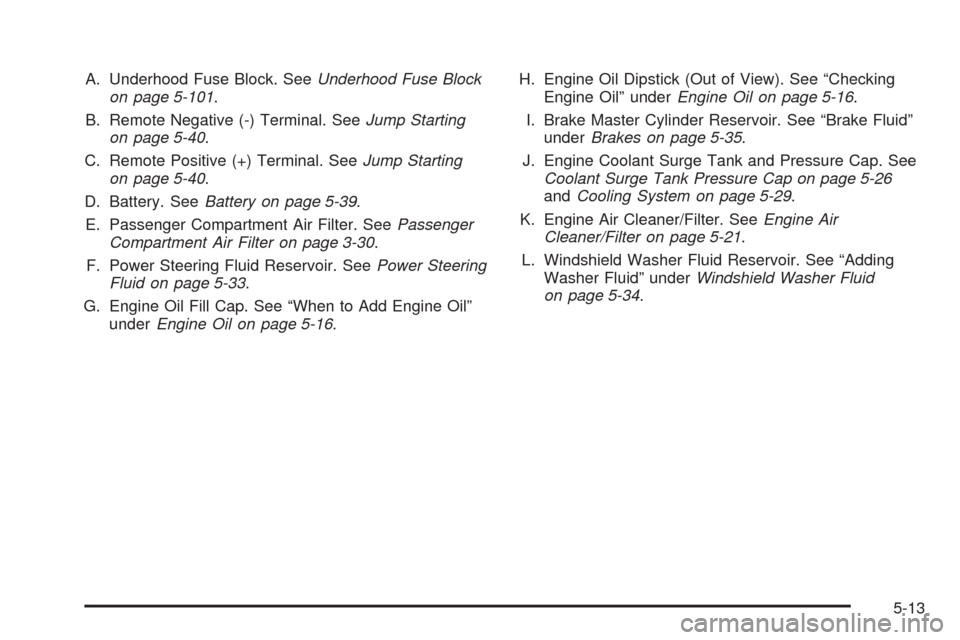
A. Underhood Fuse Block. SeeUnderhood Fuse Block
on page 5-101.
B. Remote Negative (-) Terminal. SeeJump Starting
on page 5-40.
C. Remote Positive (+) Terminal. SeeJump Starting
on page 5-40.
D. Battery. SeeBattery on page 5-39.
E. Passenger Compartment Air Filter. SeePassenger
Compartment Air Filter on page 3-30.
F. Power Steering Fluid Reservoir. SeePower Steering
Fluid on page 5-33.
G. Engine Oil Fill Cap. See “When to Add Engine Oil”
underEngine Oil on page 5-16.H. Engine Oil Dipstick (Out of View). See “Checking
Engine Oil” underEngine Oil on page 5-16.
I. Brake Master Cylinder Reservoir. See “Brake Fluid”
underBrakes on page 5-35.
J. Engine Coolant Surge Tank and Pressure Cap. See
Coolant Surge Tank Pressure Cap on page 5-26
andCooling System on page 5-29.
K. Engine Air Cleaner/Filter. SeeEngine Air
Cleaner/Filter on page 5-21.
L. Windshield Washer Fluid Reservoir. See “Adding
Washer Fluid” underWindshield Washer Fluid
on page 5-34.
5-13
Page 299 of 448
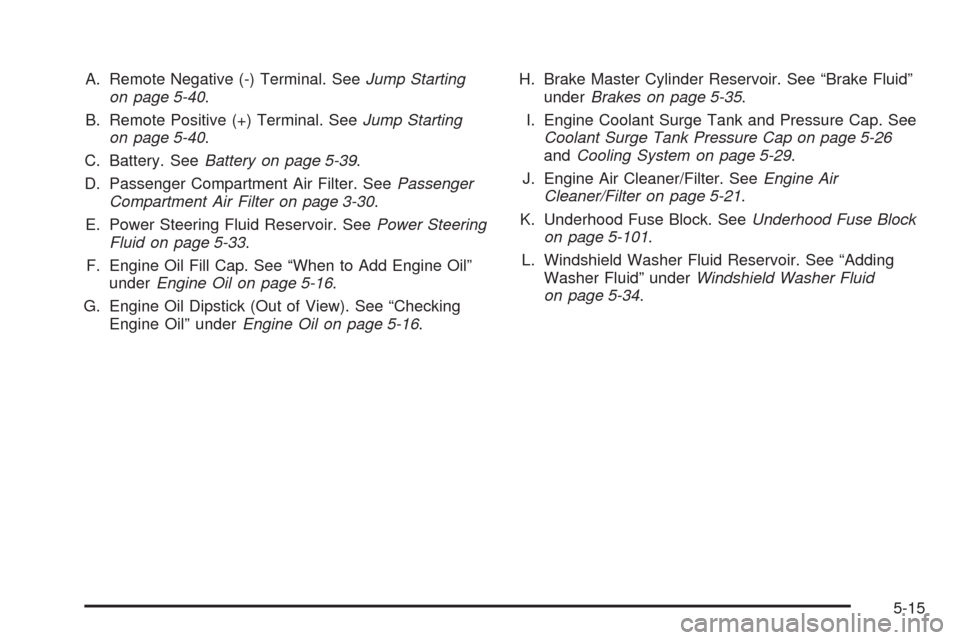
A. Remote Negative (-) Terminal. SeeJump Starting
on page 5-40.
B. Remote Positive (+) Terminal. SeeJump Starting
on page 5-40.
C. Battery. SeeBattery on page 5-39.
D. Passenger Compartment Air Filter. SeePassenger
Compartment Air Filter on page 3-30.
E. Power Steering Fluid Reservoir. SeePower Steering
Fluid on page 5-33.
F. Engine Oil Fill Cap. See “When to Add Engine Oil”
underEngine Oil on page 5-16.
G. Engine Oil Dipstick (Out of View). See “Checking
Engine Oil” underEngine Oil on page 5-16.H. Brake Master Cylinder Reservoir. See “Brake Fluid”
underBrakes on page 5-35.
I. Engine Coolant Surge Tank and Pressure Cap. See
Coolant Surge Tank Pressure Cap on page 5-26
andCooling System on page 5-29.
J. Engine Air Cleaner/Filter. SeeEngine Air
Cleaner/Filter on page 5-21.
K. Underhood Fuse Block. SeeUnderhood Fuse Block
on page 5-101.
L. Windshield Washer Fluid Reservoir. See “Adding
Washer Fluid” underWindshield Washer Fluid
on page 5-34.
5-15
Page 325 of 448
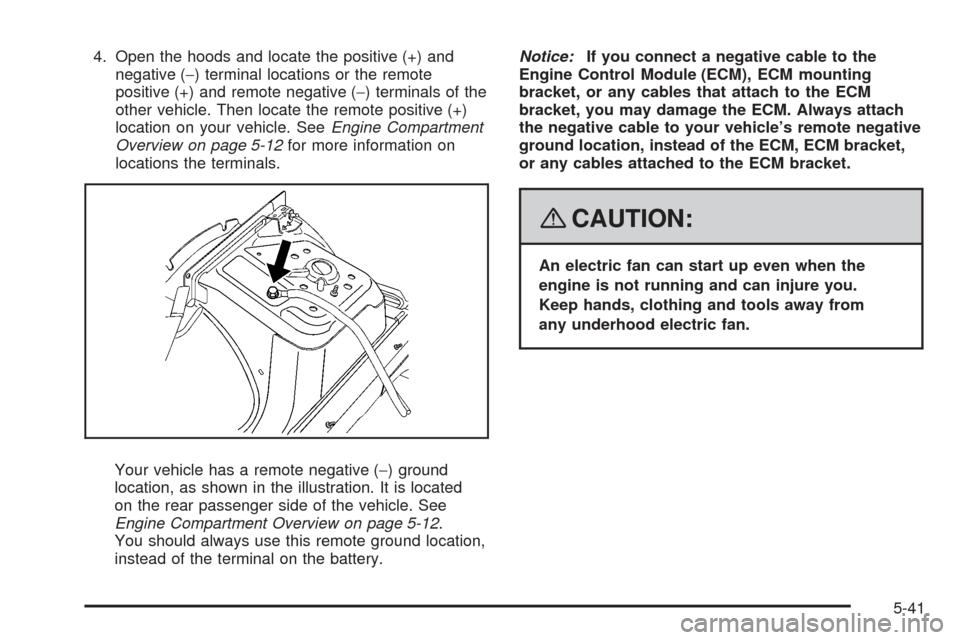
4. Open the hoods and locate the positive (+) and
negative (−) terminal locations or the remote
positive (+) and remote negative (−) terminals of the
other vehicle. Then locate the remote positive (+)
location on your vehicle. SeeEngine Compartment
Overview on page 5-12for more information on
locations the terminals.
Your vehicle has a remote negative (−) ground
location, as shown in the illustration. It is located
on the rear passenger side of the vehicle. See
Engine Compartment Overview on page 5-12.
You should always use this remote ground location,
instead of the terminal on the battery.Notice:If you connect a negative cable to the
Engine Control Module (ECM), ECM mounting
bracket, or any cables that attach to the ECM
bracket, you may damage the ECM. Always attach
the negative cable to your vehicle’s remote negative
ground location, instead of the ECM, ECM bracket,
or any cables attached to the ECM bracket.
{CAUTION:
An electric fan can start up even when the
engine is not running and can injure you.
Keep hands, clothing and tools away from
any underhood electric fan.
5-41
Page 327 of 448
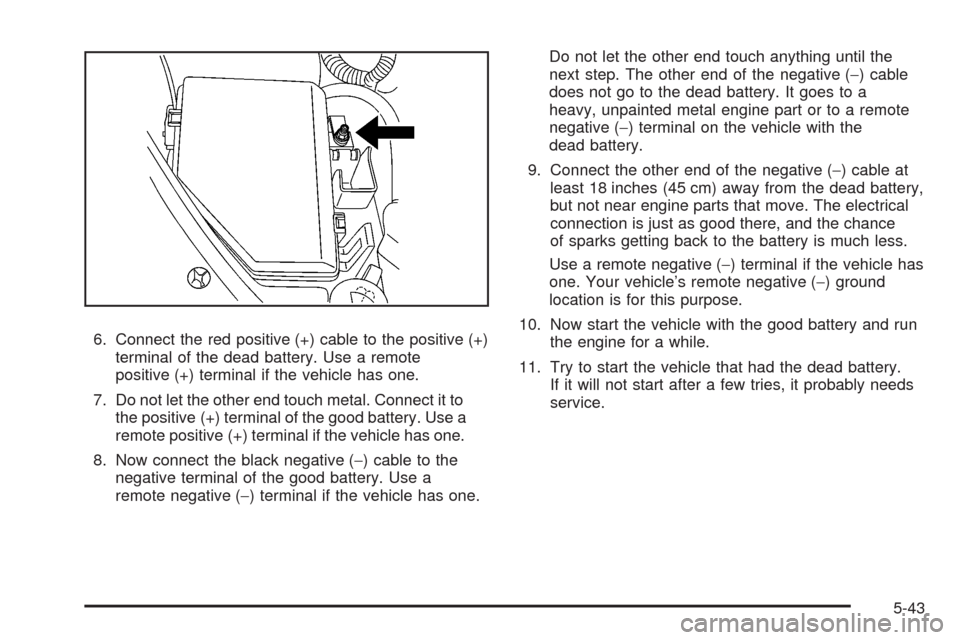
6. Connect the red positive (+) cable to the positive (+)
terminal of the dead battery. Use a remote
positive (+) terminal if the vehicle has one.
7. Do not let the other end touch metal. Connect it to
the positive (+) terminal of the good battery. Use a
remote positive (+) terminal if the vehicle has one.
8. Now connect the black negative (−) cable to the
negative terminal of the good battery. Use a
remote negative (−) terminal if the vehicle has one.Do not let the other end touch anything until the
next step. The other end of the negative (−) cable
does not go to the dead battery. It goes to a
heavy, unpainted metal engine part or to a remote
negative (−) terminal on the vehicle with the
dead battery.
9. Connect the other end of the negative (−) cable at
least 18 inches (45 cm) away from the dead battery,
but not near engine parts that move. The electrical
connection is just as good there, and the chance
of sparks getting back to the battery is much less.
Use a remote negative (−) terminal if the vehicle has
one. Your vehicle’s remote negative (−) ground
location is for this purpose.
10. Now start the vehicle with the good battery and run
the engine for a while.
11. Try to start the vehicle that had the dead battery.
If it will not start after a few tries, it probably needs
service.
5-43
Page 349 of 448
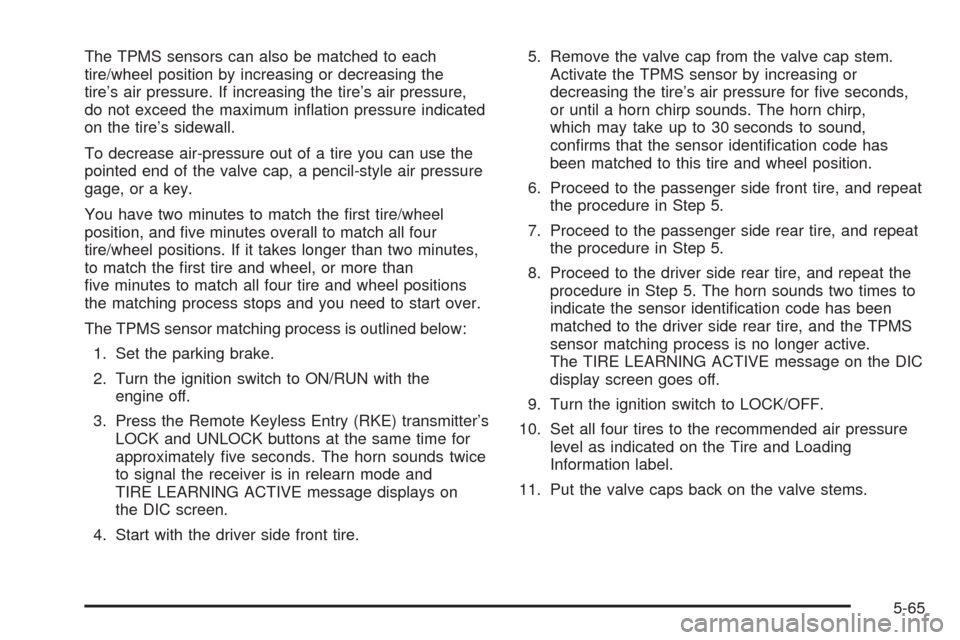
The TPMS sensors can also be matched to each
tire/wheel position by increasing or decreasing the
tire’s air pressure. If increasing the tire’s air pressure,
do not exceed the maximum in�ation pressure indicated
on the tire’s sidewall.
To decrease air-pressure out of a tire you can use the
pointed end of the valve cap, a pencil-style air pressure
gage, or a key.
You have two minutes to match the �rst tire/wheel
position, and �ve minutes overall to match all four
tire/wheel positions. If it takes longer than two minutes,
to match the �rst tire and wheel, or more than
�ve minutes to match all four tire and wheel positions
the matching process stops and you need to start over.
The TPMS sensor matching process is outlined below:
1. Set the parking brake.
2. Turn the ignition switch to ON/RUN with the
engine off.
3. Press the Remote Keyless Entry (RKE) transmitter’s
LOCK and UNLOCK buttons at the same time for
approximately �ve seconds. The horn sounds twice
to signal the receiver is in relearn mode and
TIRE LEARNING ACTIVE message displays on
the DIC screen.
4. Start with the driver side front tire.5. Remove the valve cap from the valve cap stem.
Activate the TPMS sensor by increasing or
decreasing the tire’s air pressure for �ve seconds,
or until a horn chirp sounds. The horn chirp,
which may take up to 30 seconds to sound,
con�rms that the sensor identi�cation code has
been matched to this tire and wheel position.
6. Proceed to the passenger side front tire, and repeat
the procedure in Step 5.
7. Proceed to the passenger side rear tire, and repeat
the procedure in Step 5.
8. Proceed to the driver side rear tire, and repeat the
procedure in Step 5. The horn sounds two times to
indicate the sensor identi�cation code has been
matched to the driver side rear tire, and the TPMS
sensor matching process is no longer active.
The TIRE LEARNING ACTIVE message on the DIC
display screen goes off.
9. Turn the ignition switch to LOCK/OFF.
10. Set all four tires to the recommended air pressure
level as indicated on the Tire and Loading
Information label.
11. Put the valve caps back on the valve stems.
5-65
Page 422 of 448
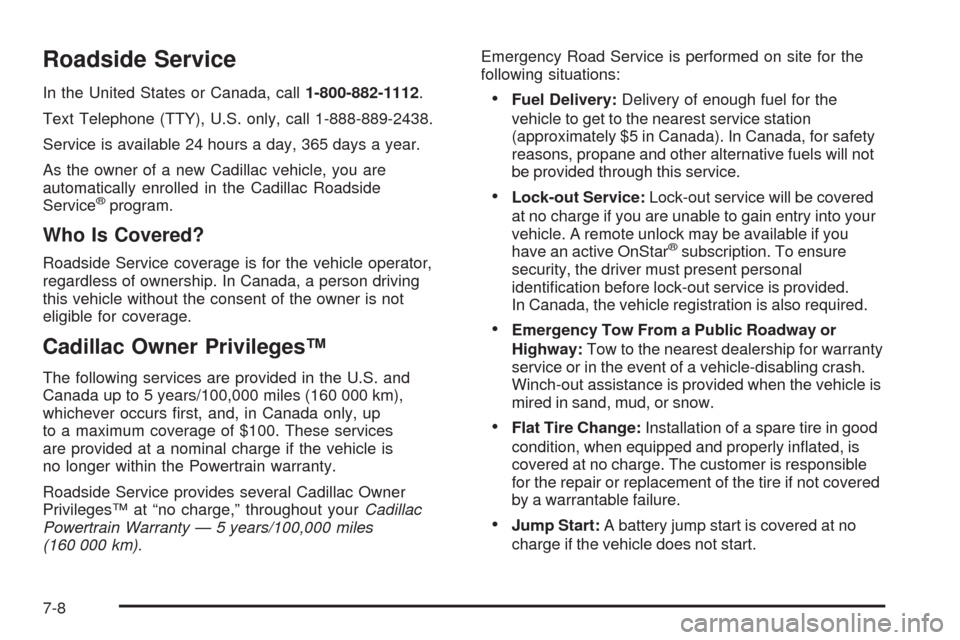
Roadside Service
In the United States or Canada, call1-800-882-1112.
Text Telephone (TTY), U.S. only, call 1-888-889-2438.
Service is available 24 hours a day, 365 days a year.
As the owner of a new Cadillac vehicle, you are
automatically enrolled in the Cadillac Roadside
Service
®program.
Who Is Covered?
Roadside Service coverage is for the vehicle operator,
regardless of ownership. In Canada, a person driving
this vehicle without the consent of the owner is not
eligible for coverage.
Cadillac Owner Privileges™
The following services are provided in the U.S. and
Canada up to 5 years/100,000 miles (160 000 km),
whichever occurs �rst, and, in Canada only, up
to a maximum coverage of $100. These services
are provided at a nominal charge if the vehicle is
no longer within the Powertrain warranty.
Roadside Service provides several Cadillac Owner
Privileges™ at “no charge,” throughout yourCadillac
Powertrain Warranty — 5 years/100,000 miles
(160 000 km).Emergency Road Service is performed on site for the
following situations:
Fuel Delivery:Delivery of enough fuel for the
vehicle to get to the nearest service station
(approximately $5 in Canada). In Canada, for safety
reasons, propane and other alternative fuels will not
be provided through this service.
Lock-out Service:Lock-out service will be covered
at no charge if you are unable to gain entry into your
vehicle. A remote unlock may be available if you
have an active OnStar
®subscription. To ensure
security, the driver must present personal
identi�cation before lock-out service is provided.
In Canada, the vehicle registration is also required.
Emergency Tow From a Public Roadway or
Highway:Tow to the nearest dealership for warranty
service or in the event of a vehicle-disabling crash.
Winch-out assistance is provided when the vehicle is
mired in sand, mud, or snow.
Flat Tire Change:Installation of a spare tire in good
condition, when equipped and properly in�ated, is
covered at no charge. The customer is responsible
for the repair or replacement of the tire if not covered
by a warrantable failure.
Jump Start:A battery jump start is covered at no
charge if the vehicle does not start.
7-8
Page 434 of 448
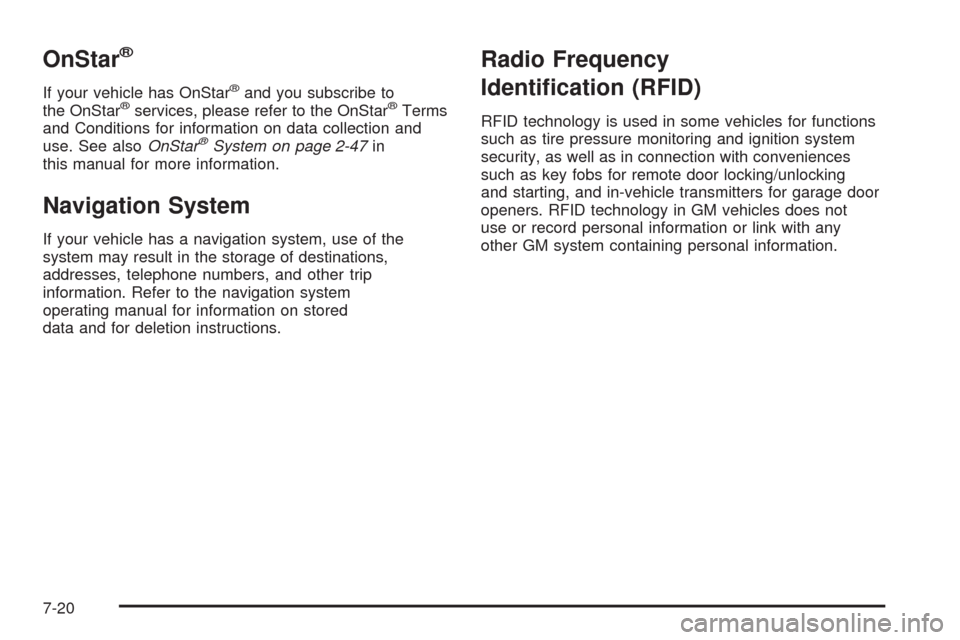
OnStar®
If your vehicle has OnStar®and you subscribe to
the OnStar®services, please refer to the OnStar®Terms
and Conditions for information on data collection and
use. See alsoOnStar
®System on page 2-47in
this manual for more information.
Navigation System
If your vehicle has a navigation system, use of the
system may result in the storage of destinations,
addresses, telephone numbers, and other trip
information. Refer to the navigation system
operating manual for information on stored
data and for deletion instructions.
Radio Frequency
Identi�cation (RFID)
RFID technology is used in some vehicles for functions
such as tire pressure monitoring and ignition system
security, as well as in connection with conveniences
such as key fobs for remote door locking/unlocking
and starting, and in-vehicle transmitters for garage door
openers. RFID technology in GM vehicles does not
use or record personal information or link with any
other GM system containing personal information.
7-20
Page 444 of 448
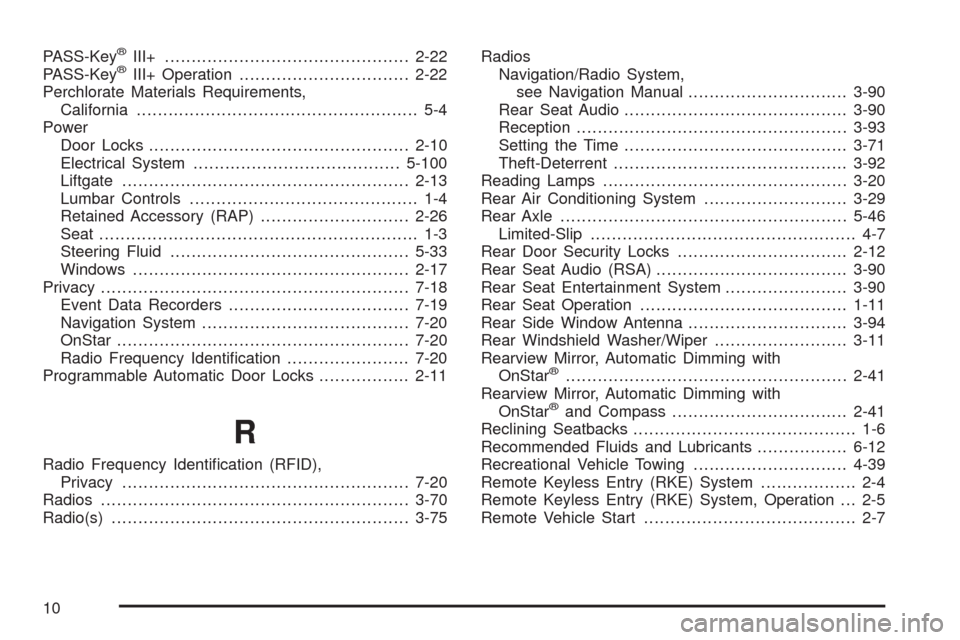
PASS-Key®III+..............................................2-22
PASS-Key®III+ Operation................................2-22
Perchlorate Materials Requirements,
California..................................................... 5-4
Power
Door Locks.................................................2-10
Electrical System.......................................5-100
Liftgate......................................................2-13
Lumbar Controls........................................... 1-4
Retained Accessory (RAP)............................2-26
Seat............................................................ 1-3
Steering Fluid.............................................5-33
Windows....................................................2-17
Privacy..........................................................7-18
Event Data Recorders..................................7-19
Navigation System.......................................7-20
OnStar.......................................................7-20
Radio Frequency Identi�cation.......................7-20
Programmable Automatic Door Locks.................2-11
R
Radio Frequency Identi�cation (RFID),
Privacy......................................................7-20
Radios..........................................................3-70
Radio(s)........................................................3-75Radios
Navigation/Radio System,
see Navigation Manual..............................3-90
Rear Seat Audio..........................................3-90
Reception...................................................3-93
Setting the Time..........................................3-71
Theft-Deterrent............................................3-92
Reading Lamps..............................................3-20
Rear Air Conditioning System...........................3-29
Rear Axle......................................................5-46
Limited-Slip.................................................. 4-7
Rear Door Security Locks................................2-12
Rear Seat Audio (RSA)....................................3-90
Rear Seat Entertainment System.......................3-90
Rear Seat Operation.......................................1-11
Rear Side Window Antenna..............................3-94
Rear Windshield Washer/Wiper.........................3-11
Rearview Mirror, Automatic Dimming with
OnStar
®.....................................................2-41
Rearview Mirror, Automatic Dimming with
OnStar
®and Compass.................................2-41
Reclining Seatbacks.......................................... 1-6
Recommended Fluids and Lubricants.................6-12
Recreational Vehicle Towing.............................4-39
Remote Keyless Entry (RKE) System.................. 2-4
Remote Keyless Entry (RKE) System, Operation . . . 2-5
Remote Vehicle Start........................................ 2-7
10
Page 446 of 448
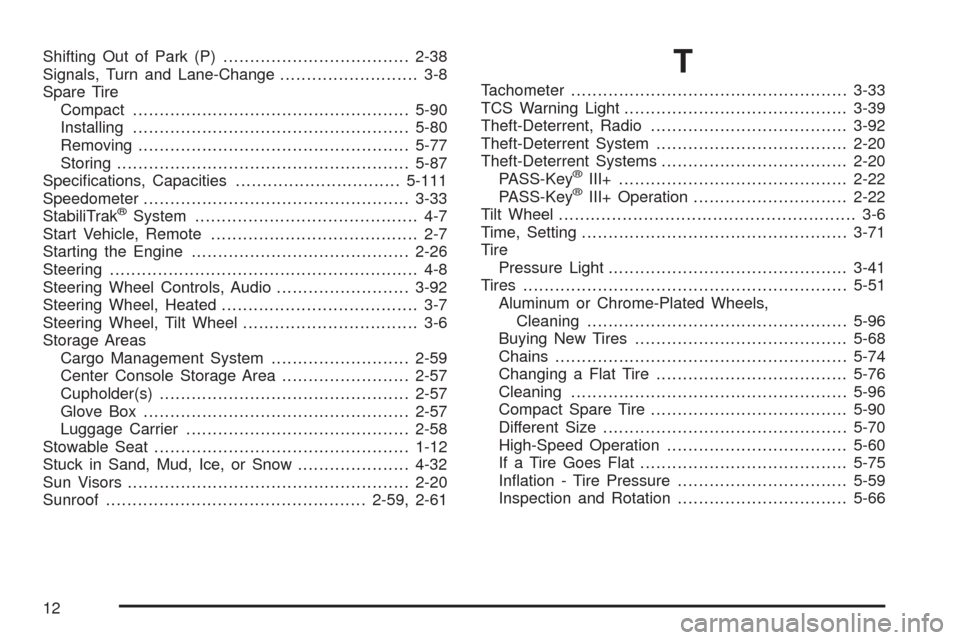
Shifting Out of Park (P)...................................2-38
Signals, Turn and Lane-Change.......................... 3-8
Spare Tire
Compact....................................................5-90
Installing....................................................5-80
Removing...................................................5-77
Storing.......................................................5-87
Speci�cations, Capacities...............................5-111
Speedometer..................................................3-33
StabiliTrak
®System.......................................... 4-7
Start Vehicle, Remote....................................... 2-7
Starting the Engine.........................................2-26
Steering.......................................................... 4-8
Steering Wheel Controls, Audio.........................3-92
Steering Wheel, Heated..................................... 3-7
Steering Wheel, Tilt Wheel................................. 3-6
Storage Areas
Cargo Management System..........................2-59
Center Console Storage Area........................2-57
Cupholder(s)...............................................2-57
Glove Box..................................................2-57
Luggage Carrier..........................................2-58
Stowable Seat................................................1-12
Stuck in Sand, Mud, Ice, or Snow.....................4-32
Sun Visors.....................................................2-20
Sunroof.................................................2-59, 2-61
T
Tachometer....................................................3-33
TCS Warning Light..........................................3-39
Theft-Deterrent, Radio.....................................3-92
Theft-Deterrent System....................................2-20
Theft-Deterrent Systems...................................2-20
PASS-Key
®III+...........................................2-22
PASS-Key®III+ Operation.............................2-22
Tilt Wheel........................................................ 3-6
Time, Setting..................................................3-71
Tire
Pressure Light.............................................3-41
Tires.............................................................5-51
Aluminum or Chrome-Plated Wheels,
Cleaning.................................................5-96
Buying New Tires........................................5-68
Chains.......................................................5-74
Changing a Flat Tire....................................5-76
Cleaning....................................................5-96
Compact Spare Tire.....................................5-90
Different Size..............................................5-70
High-Speed Operation..................................5-60
If a Tire Goes Flat.......................................5-75
In�ation - Tire Pressure................................5-59
Inspection and Rotation................................5-66
12